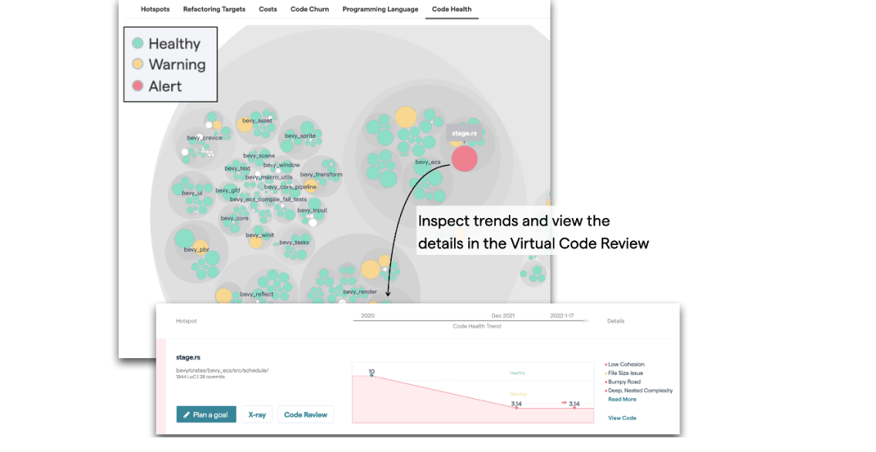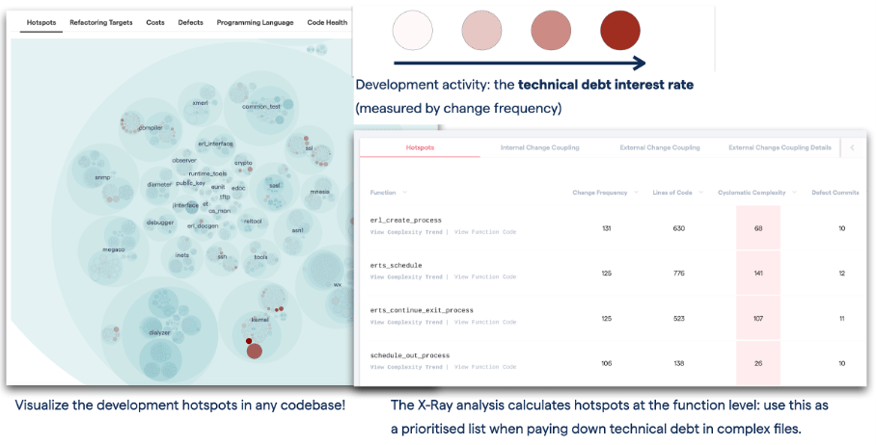The Rust programming language has grown in popularity since its initial release back in 2010. Rust keeps showing up as the most loved programming language in StackOverflow’s annual survey, it has a rich ecosystem and active support by several large companies. It’s here to stay.
At CodeScene, we’re proud to announce that we have added full support for analyzing Rust codebases. Our Rust support is available in the free community edition for open source projects, as well as in all our paid plans. Let’s look at some of the key features of CodeScene’s Rust support.
Visualize Code Health in a Rust codebase
Code quality issues cost time, money, and missed deadlines. Hence, it’s vital for to know when you can safely move ahead and implement new features as well as when you might have to take a step back and improve what’s already there. This is a hard balance in any development project. Let’s see how the code health concept helps.
 Inspecting trends in the Virtual Code Review
Inspecting trends in the Virtual Code Review
Code health is an aggregated metric based on 25+ factors scanned from the source code. The code health factors are known – from research – to correlate with lower developer productivity and an increased risk for bugs. With CodeScene, you automatically visualize the code health of any codebase. This lets you identify areas with green and healthy code – the parts that are predictable to work in and low risk for future development – as well as areas of the code that require more attention (yellow and red code).
The code health support for Rust also comes with a virtual code reviewer that highlights all issues, including explanations on what they mean accompanied by recommendations on how to fix them.
Prioritize refactoring based on the X-Ray analysis
With the code health metric covered, it’s also important to point out that just because some code lacks in quality that doesn’t mean it's technical debt that has to be fixed immediately. In fact, the main danger in prioritizing improvements, redesigns, etc. based on code quality issues alone is that we miss the most important decision point: impact.
And this is where CodeScene differs the most from static analysis: CodeScene’s behavioral code analysis perspective prioritizes based on how the code evolves and how the development teams interact with the code. We call this perspective Hotspots.
 Hotspots lets you prioritize code health issues
Hotspots lets you prioritize code health issues
Development hotspots introduce a time perspective into your codebase. This perspective lets you reason about code health issues within the context of how your team works with the code. However, occasionally you will come across these large and overly complex files that seem to have accumulated tons of code. In situations like that the X-Ray analysis comes in handy by letting you prioritize hotspots at the function level. That way, you get a clear and actionable starting point even in the most complex hotspots.
Make it actionable: integrate with pull requests
Finally, all CodeScene plans – community edition included lets you integrate these analyses into pull requests. It’s been a popular integration that helps development teams and OS maintainers by serving as a quality gate and early feedback loop. Read all about CodeScene’s pull request integration.
It's easy to create a free account or a paid plan for closed-source projects. CodeScene is free for all open source repositories and (very) affordable for closed source projects. In addition to Rust programming language, CodeScene supports a total of 28 programming languages (Java, C#, C++, Python, JavaScript, etc.).
Check it out – this is your code like you haven’t seen it before!